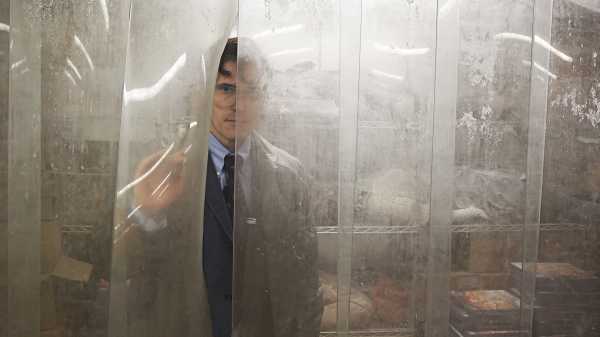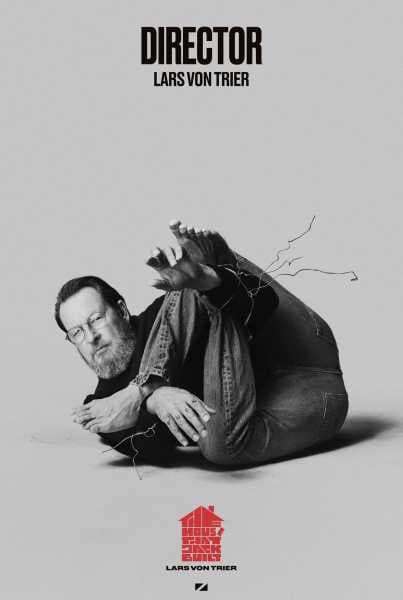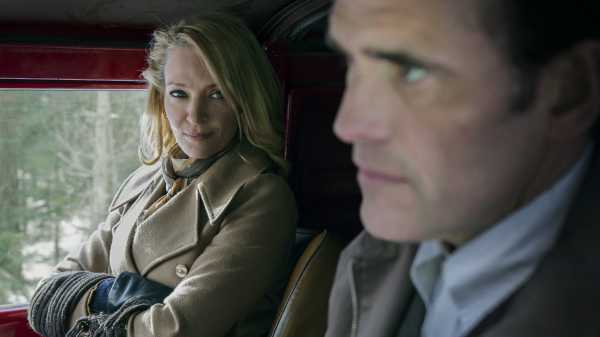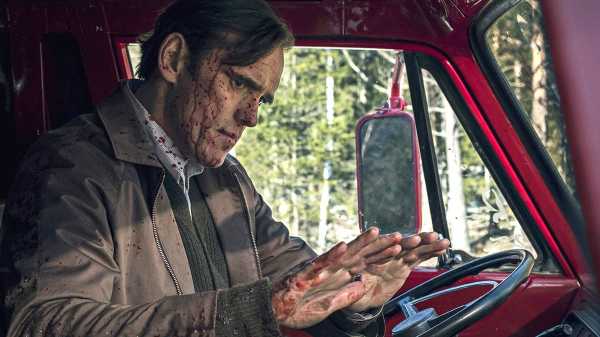
The House That Jack Built, Lars von Trier’s disturbingly graphic new film about a serial killer who mutilates women and children, has been a topic of debate since the moment it debuted.
The film prompted mass walkouts at its Cannes premiere in May. Early reviews ranged in tone from outraged to unenthused to almost ecstatic. On the whole, reactions to the film were so vehement that some wondered if the movie was too controversial to be released at all.
But now, The House That Jack Built is getting not just one, but two different theatrical releases before the end of the year.
The first was on November 28, when the film’s unrated “director’s cut” played in a series of one-day-only screenings. On December 14, an R-rated version of the film will be released in limited theaters and for rent on digital platforms.
The director’s cut was originally scheduled for digital release in December, alongside the R-rated version. But following the November 28 screenings, the Motion Picture Association of America threatened to sanction IFC, the film’s distributor, for releasing an unrated version and a rated version so close together, saying that doing so was “in violation of the ratings system’s rules.” (A sanction by the MPAA might have prevented any other films from IFC from being rated for up to 90 days, which would affect those films’ marketability with theaters that typically won’t show an unrated film.) As a result of these threatened sanctions, the digital release of the director’s cut is now tentatively scheduled for June 2019.
But regardless of the two versions’ respective release dates, they signal an evolution in the way distributors are thinking about particularly graphic films. Typically, a movie would only screen in theaters in one form; indeed, some of von Trier’s past works have been released in theaters solely as unrated cuts. But The House That Jack Built is ultimately getting two theatrical releases, one for each version of the film.
Why is that? The short answer is simple: money. But there’s a longer explanation, too, revealing the tactics that the film’s distributors are using to help the film build buzz and make money from American audiences.
Controversial filmmaking is familiar territory for von Trier, who relishes scandalizing audiences
The walkouts at Cannes weren’t unusual unto themselves; the glitzy French festival is known for its boisterous audiences, which often signal their approval of a film — or their disgust in it — with whatever the situation calls for. Responses can include cheers or boos, standing ovations or walkouts.
But the walkouts from The House That Jack Built were surprising in one big respect: To many industry observers, it was startling that the film was playing at Cannes in the first place.
That’s because von Trier, who’s made a career of directing provocative films like Breaking the Waves, Dogville, Antichrist, and Nymphomaniac, was banned from the festival in 2011. In a press conference before von Trier’s film Melancholia premiered in competition that year, a journalist asked the director about his German roots and his use of a “Nazi aesthetic” in the film. Von Trier’s response included a statement that he “understands” and “sympathizes” with Hitler, and that he is, himself, a Nazi.
The comment seemed likely to have been made in (ill-advised) jest, but uproar ensued. Von Trier quickly issued an apology, claiming he had simply made a provocative joke, but festival director Thierry Fremaux declared him “persona non grata” at Cannes. And though Fremaux said the ban would only last one year, von Trier’s two-part “sex epic” Nymphomaniac did not premiere at Cannes in 2014.

So the announcement that The House That Jack Built would premiere out of competition in 2018 raised some eyebrows, given von Trier’s penchant for provocative material. And the stir only grew after people actually saw the film. Matt Dillon stars as a serial killer named Jack, and the film chronicles five of Jack’s most pivotal killings — which involve the gruesome dismemberment of children and a scene that can only be described as misogynistic human taxidermy. A meandering, sometimes philosophical conversation between Jack and an off-screen interlocutor is interspersed with Jack’s murders.
The film is hardly out of character for Von Trier, who is no stranger to controversy. His 2009 film Antichrist starred Willem Dafoe and Charlotte Gainsbourg as a bereaved couple coping with their grief through, among other things, graphic genital mutilation. Nymphomaniac drew criticism from some quarters for its unsimulated sex and sadism. Both of those films were eventually released without a rating in the US.
For some audience members and critics — even some who had defended von Trier in the past — The House That Jack Built was a bridge too far in depicting grotesque violence, particularly against women and children. At the Playlist, Jessica Kiang called the movie “repulsive, toxic trash”:
And at Pajiba, Caspar Salmon wrote, “When I left The House That Jack Built, it was because I could no longer remember why I was doing this anymore. I could suddenly not recall why films did this; I could not remember why the torture, abuse and murder of women was a subject matter, to be assessed by me after being made to endure it.”
But some critics loved the film, calling it “possibly brilliant,” or reading it as von Trier’s attempt to sneer back at the comments that got him banned from Cannes seven years prior. For his part, the director characterized the film in interviews as his attempt to make the audience “think.” He has also claimed a far-reaching right to free speech, said he enjoyed the outrage, and declared the film “celebrates the idea that life is evil and soulless, sadly proven by the recent rise of the Homo trumpus — the rat king” — by which he meant Donald Trump.
IFC acquired the film for US release, and announced a few weeks ago that the “director’s cut” of the film — the version that played at Cannes — would receive a one-day-only unrated release on November 28 in theaters across America.
But in a move that diverges from the unrated theatrical releases of Antichrist and Nymphomaniac, a second, R-rated version of The House That Jack Built will be released in theaters on December 14. That choice has a clear reasoning behind it.

In its original state, a film like The House That Jack Built is too violent even for an R rating
In most cases, only one version of a film is released theatrically, and any “extended” or “unrated” cuts are made available when the film moves to home video release. So why would IFC release two different versions The House That Jack Built in theaters — especially since von Trier’s most recent controversial films were only released as unrated cuts?
IFC declined to give a definitive answer when I reached out for comment, with a publicist simply writing via email, “We wanted to make sure audiences could see both versions so we have made them both available.” But since R-rated cuts of other von Trier films were never released — in theaters or other formats — that doesn’t fully answer the question.
The answer seems pretty obvious: revenue. But to understand why, you have to know how the MPAA ratings system works.
The MPAA is the entertainment industry’s member organization for the major movie studios. In brief, all filmmakers and production companies can choose to voluntarily submit their movies to the MPAA’s ratings board, a group of people employed by the organization who are mostly anonymous. Those people watch films and assign them a rating based on established criteria concerning sex, profanity, and violence.
How much money your film makes often depends on the rating it receives. Most movie theaters — operating on a “gentleman’s agreement” with the MPAA — will not let anyone younger than age 17 attend an R-rated film without an adult, and some people (for reasons of conscience or otherwise) won’t attend R-rated films no matter how old they are. The result is that PG-13 rated movies usually make about twice as much money as R-rated films at the box office. (That’s why most blockbusters are rated PG-13.)
But even an R-rated film makes more money than movies that are rated NC-17, a designation meant to exclude any moviegoer under age 17, whether or not they are accompanied by an adult. There’s no legal reason for this; it’s just the policy at most movie theaters, particularly multiplex chains, in the US. And NC-17 films are rated that way for graphic sexual content or graphic violence, so many people prefer not to see them anyhow.
The NC-17 rating was created as a replacement for the older “X” rating, which was originally intended to denote a film that hadn’t been rated. But when the X rating was ultimately co-opted as a marketing tool by pornographic film distributors, its intended meaning became moot. So the NC-17 designation, by contrast, has always been a true rating; rather than meaning “unrated,” it denotes that a film contains particularly mature or violent content. And it has come to carry a stigma of its own, similar to what an X would have denoted to viewers in the past.
An NC-17 rating cuts way down on the number of people who can or will attend a film, and so for that reason alone, many theaters refuse to even carry NC-17 films. Why devote an entire theater screen to a movie that most people won’t even pay to see? It doesn’t make good business sense.

It costs money to make a film, and the inherent goal is usually to recoup that cost. So sometimes, filmmakers who receive an NC-17 rating will recut the film to receive an R rating instead, thus making the film palatable to movie theaters and a broader audience. You’ll likely get your movie into theaters and sell at least some tickets with an R rating (though not as many as you would if the movie was rated PG-13). That’s what most production companies and distributors are ultimately after.
Occasionally, though, a film that receives (or definitely would receive) an NC-17 rating is simply released as “unrated,” to bypass the stigma that comes with the NC-17 rating. It’s a little silly: Movies that don’t contain graphic content are rarely released unrated, at least theatrically, but the semantics do matter to many people, whether they’re theater owners or audience members. Often, a film that was initially recut to receive a theater-friendly R rating will come out with an unrated version as well, sometimes called a director’s cut, aimed at home video audiences.
The release of two versions will likely maximize the audience — or at least bring in everyone who’s curious
Lars von Trier is obviously not concerned with his films’ marketability to a broad audience. He often makes the kind of films that give even extreme horror obsessives pause. You don’t go to see a von Trier movie about a serial killer to scream a little; you go to be pushed, to be challenged, to be scandalized and horrified.
Rather than being released with an NC-17 rating, both Antichrist and Nymphomaniac were released in theaters as unrated. That’s perfectly fine. Such films lack the stigma of an NC-17 rating, and are unlikely to screen in multiplexes, but they still play in art-house cinemas, and can be rented and watched at home (in the case of Nymphomaniac, several versions are available).
The House That Jack Built release, however, appears designed to maximize the potential for the film to earn money on the back of its graphic content. The marketing copy for the one-night-only director’s cut screenings capitalized on its controversial reputation, referring to the film as “the same version that was shown at this year’s Cannes Film Festival and prompted both a 10-minute standing ovation and more than a few disturbed walkouts.”
That’s calculated to tantalize a certain breed of moviegoer, more or less a dare: Are you strong enough to watch the movie that others could not? It worked: Many of the November 28 screenings were completely sold out. And in a social media-driven world, that matters. People who attend those screenings will likely post public commentary about the film, driving up interest. It’s a smart business reason to turn the unrated screenings in an “event” before the general release.

Then a few weeks later, after the initial wave of buzz, The House That Jack Built will have its R-rated theatrical release, which promises slightly less graphic violence, while still obviously being disturbing. That version of the film will likely bring in a broader audience, in addition to remaining in theaters for more than a day, resulting in more ticket sales.
Importantly, the digital version of the R-rated film will only be available for rent. The director’s cut won’t be available for many months, and then only for purchase. It’s easy to imagine a scenario in which a person sees the R-rated film in theaters or rents the R-rated cut, and then gets curious about what was left out and, next summer, buys the director’s cut — all of which contributes to the film’s overall revenue. (Especially since the typical cost of purchasing a film digitally is roughly the same as seeing it in a theater.)
So the dual release of The House That Jack Built, fueled by social media buzz and its reputation from Cannes, is poised to be a smart move for the film’s distributor while also maximizing the money that a graphically violent von Trier film can bring in. It still won’t reach a broad audience. But anyone who wants to see it, or is curious, will have that opportunity, as long as they’re willing to buy a ticket or hand over a credit card number.
That seems like just what von Trier wants. “It’s quite important not to be loved by everybody, because then you’ve failed,” he told Cineuropa this summer. “I’m not sure if they hated [The House That Jack Built] enough, though. If it gets too popular, I’ll have a problem.”
Sourse: vox.com






